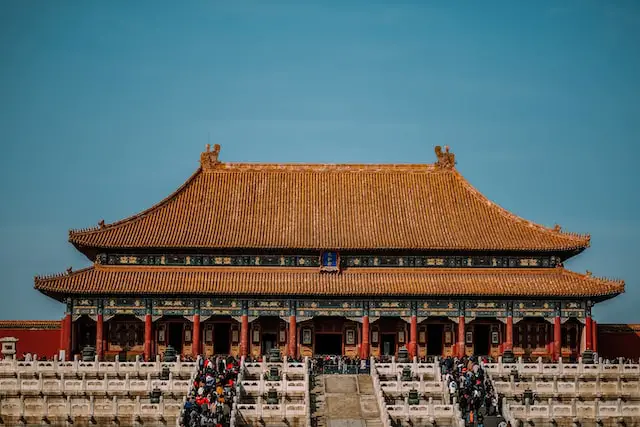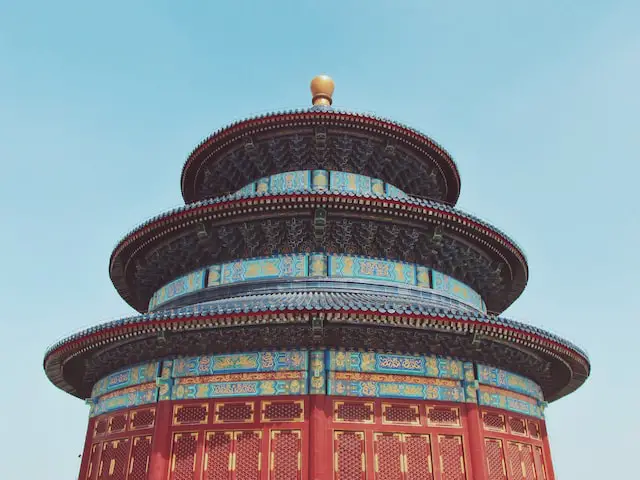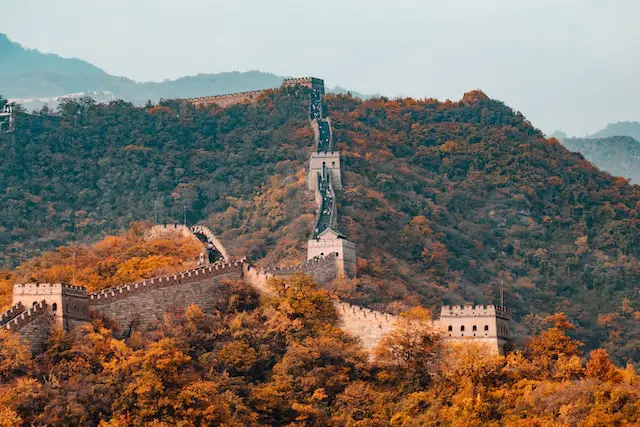China is home to over 1.4 billion people and has an incredible history that dates back over 3,000 years to the Shang Dynasty of 1600 – 1046 BC. With such a rich history and an abundance of incredible sites, it’s no wonder that China is a top destination for historians and tourists alike. So, let’s take a tour together of the must-see majestic historical places in China that should be on everyone’s list.
Disclosure: Untold Wanderlust contains affiliate links. If you click on these links and make a purchase, we will earn a small commission at no extra cost to you. You can find our full disclosure policy and privacy policy here.
Great Wall of China
Evidence suggests that the Great Wall is over 2,700 years old, making it one of China’s oldest and most significant historical landmarks. This giant military defence line was built with the aim of preventing northern nomadic tribes from invading central China. The length of the Great Wall of China, which begins in Jiayuguan and ends at Hushan, is 21,196.18 km and was primarily constructed during the Ming Dynasty (1368 – 1644). The two most popular sections of the Great Wall for visitors are Mutianyu and Badaling in Beijing.
The Forbidden City
The Forbidden City is a large palace complex in Beijing with 12 palaces, almost 100 buildings and over 9,000 rooms. The palace complex was the world’s largest during the Ming and Qing Dynasties. For over 500 years, this has been one of China’s most important political and ritual centre points, and to this day remains an important hub for Chinese culture. Twenty-four emperors and their families spent their lives here, and it is considered one of the most beautiful examples of Chinese architecture and design. Reached via Tiananmen Square, the city is the perfect location for tourists searching for a glimpse into China’s magnificent imperial past.

The Potala Palace
The Potala Palace is a must-see attraction for those interested in Tibetan culture. This palace was initially built by the Tu-Bo Dynasty founder, Songtsen Gampo (617-650). In the early 17th century, it was transformed into the winter residence and headquarters of the Dalai Lama and used as such until 1959. The palace houses thousands of valuable historical relics, including over 10,000 Buddha statues made from gold, silver, wood or clay and many ornate thangka (Tibetan) paintings. There is no doubt that this museum is absolutely stunning with its magnificent murals, wooden carvings and colour paintings.
The Terracotta Army
Undoubtedly, the Terracotta Army is one of the best-known historical attractions in China and has become a must-see for all visitors on a wider trip to China. It is said that the underground army (which also includes horses and chariots) was established by Emperor Qin Shi Huang, the first emperor of unified China, so he might be protected in the afterlife. Over 720 thousand labourers worked on the project for nearly 40 years. Visitors to the site cannot fail to gain an appreciation for ancient Chinese culture along with the hard work and determination that was put into the completion of the sculpture army.
The Summer Palace
The Summer Palace is China’s largest imperial garden. It is a harmonious ensemble of pavilions, halls, palaces, temples and bridges scattered throughout the natural hilly landscape and lakes. In 1998, UNESCO listed this 740-acre site as a World Heritage Site and described it as a masterpiece of Chinese landscape gardening. During the Qing Dynasty, the Summer Palace was a royal summer resort, so its architecture and layout are pretty impressive. Next to the palace, you can walk along the famous Suzhou Street, filled with shops selling antiques, snacks, silks, jewellery, and tea or have your photo taken in traditional costume.
The Temple of Heaven
It was Emperor Yongle who erected the Temple of Heaven in 1420 for rulers to worship during the Ming Dynasty. In line with Chinese traditional religious concepts, it consists of a vast complex with multiple structures. Its most spectacular feature is the Hall of Prosperous Harvests, where emperors made sacrifices to pray for prosperous harvests. Similarly, the Circular Mound Altar and Imperial Vault of Heaven are genuine architectural monuments of the Ming and Qing dynasties.

The Mogao Grottoes
Also known as the Thousand Buddha Caves, the Mogao Grottoes are a must-see cave system known for their beautiful paintings and sculptures. Here, visitors can find over 50,000 historical treasures, including 735 grottoes, 450,000 square metres of murals and 2,415 clay Buddha sculptures. With carvings dating back to 366 AD, and a construction period spanning 16 dynasties, the Mogao Grottoes showcase Buddhist art at its best. Located near Dunhuang, the Mogao Grottoes are also one of the best places to see the ancient Silk Road.
The Three Confucius Sites
The Three Confucius Historical Sites, known as San Kong, are located in Qufu, Shandong Province. It was here that Confucius’ descendants lived in the Kong Family Mansion, and its separation of work, reception and relaxation areas reflect Confucian philosophy. More than 100,000 descendants of Confucius are buried here in the Cemetery of Confucius. The site is also home to the Qufu Confucius Temple, the world’s second-largest ancient architectural complex after the Forbidden City.
The Shaolin Temple
Every year, more than 100 million pilgrims and tourists from home and abroad visit the birthplace of Chinese martial arts, notably Kung Fu and Zen Buddhism. Located near the base of the Songshan Mountain in Henan Province, the temple comprises several buildings and courtyards, a training centre, a show hall and a pagoda forest. To this day, parts of the temple are still in use. Monks use this sacred place as a training centre for young men to learn martial arts and Buddhist culture. When visiting, you might be lucky enough to see the young monks learning these ancient practices.
The Han Yangling Mausoleum
Zhangjiawan Village, about 20 kilometres north of Xi’an City, Shaanxi Province, is home to the Yangling Mausoleum of the Han Dynasty. Liu Qi and Wang, an empress of the Western Han Dynasty, are buried together in this tomb. The Han Yang Ling Mausoleum, neatly arranged and centred around the emperor’s tomb, gives insight into the strict hierarchy of Chinese society. If you cannot make it to China, you can enter a world of emperors in the 3 Kingdoms slots at most online casinos. If you do manage to make it to China, this is a spot not to be missed.
Conclusion
For both history fans and keen tourists, it is evident that China has an abundance of incredible attractions to visit and explore. Some of these sites may be combined into a comprehensive tour, or, for those seeking a specific experience, the tour can be tailored to suit your interests and timeframe. There is no doubt that whatever your goal, China’s numerous and impressive historical sites, architecture and culture are sure to astonish and delight you. So, what are you waiting for? Get ready to explore these awesome historical places in China.


